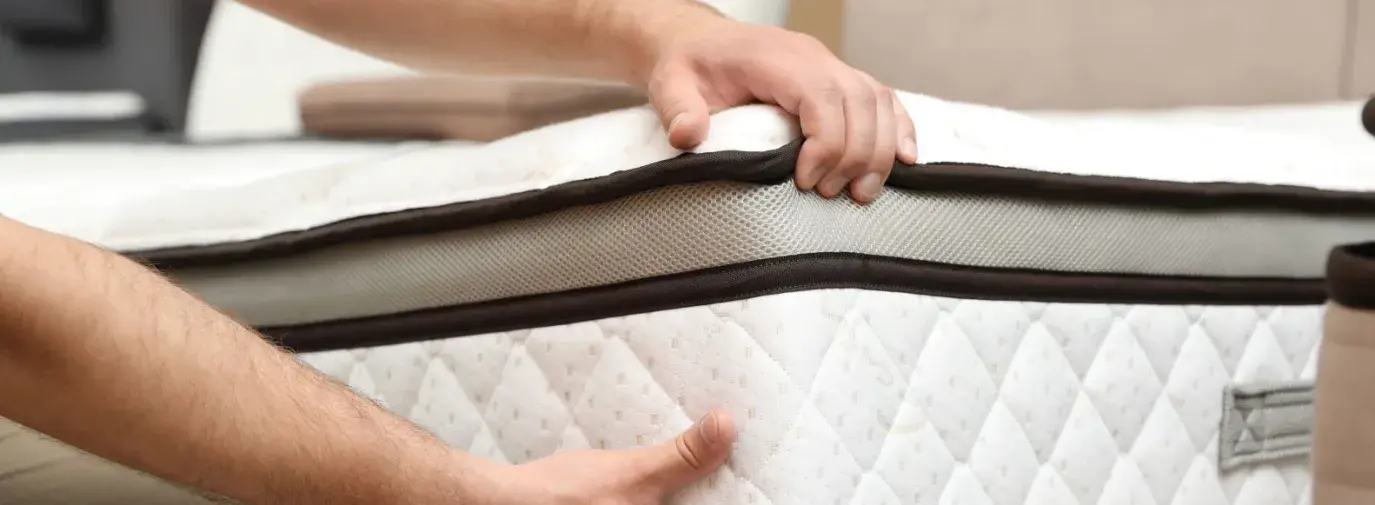
Guest written by Jonathan Sharp of the Environmental Litigation Group
Popular discount mattresses are using fiberglass in place of safe and natural flame retardants. If you unknowingly unzip your mattress, you could face serious health problems and costs. Learn about the problems with fiberglass and find a truly safe, green mattress from Green America’s certified green businesses.
Why Is Fiberglass Harmful?
Since 2007, mattress manufacturers in the United States have been required by law to add a fire retardant to their products. The most common flame retardant used in modern mattresses, especially the less expensive ones, is fiberglass. The tiny glass fibers woven together to form a protective layer are built into the mattress to create a barrier between the highly flammable memory foam and a possible open flame. Many companies use fiberglass because it is widely available and cheap.
Recently, the mattress manufacturer Zinus, one of the most popular brands in the country, has gained negative attention due to a design defect. The flaw lies in its zippable cover, which, even though it suggests it’s removable, it’s not—due to its 62% fiberglass content.
Removing the outer cover of any mattress containing fiberglass will expose the inner layer. With the slightest disturbance, tiny, sharp pieces of glass can and will spread throughout the room and contaminate your whole home. Exposure to fiberglass can cause skin rashes, lacerations, eye injuries, dermatitis, upper respiratory infections, gastrointestinal problems, and the aggravation of asthma and bronchitis.
Fiberglass Is Almost Impossible to Remove
Sadly, numerous families who made the mistake of unzipping their mattresses experienced extreme contamination with fiberglass in their houses. Many people had to throw away most of their belongings. Glass fibers are very sharp and have rough edges, meaning they attach to objects made of or covered in fabric, such as carpets, pillows, clothes, couches, and drapes.
Fiberglass contamination takes a tremendous emotional and financial toll, between associated medical costs and the cost of fiberglass removal, which can be carried out only by professionals.
How to Choose a Safe Mattress
There are many reasons to seek out an all-natural mattress. Not only do you avoid breathing in all the off-gassed chemicals that memory foam is usually treated with, but some of these materials, for example, organic wool, are natural flame retardants that can easily exceed the flammability standards required by law without adding in any chemicals. These mattresses are also a lot friendlier to the environment, and they have a longer lifespan.
If you want to make sure the mattress you’re sleeping on doesn’t affect your health, the best way to do that is to figure out precisely what’s inside your mattress. Reading the label, asking the manufacturer directly, and seeking out trustworthy and reliable sources regarding the product you’re interested in, should be a good starting point. Unfortunately, just because a mattress is labeled “organic” does not mean it’s safe. Many companies add just one organic component to an otherwise toxic product and call it organic.
In general, avoid synthetic materials such as polyurethane foam, synthetic latex, and chemical compounds. Look for mattresses made entirely of organic fabrics instead, and stay away from fiberglass. If you can’t easily find this kind of information about the mattress you’re interested in, consider it a red flag. Most organic mattress companies are usually quite transparent about the manufacturing process and the materials used.
You should also make sure that the company is appropriately certified. Two of the most important certifications to look for are GOLS-Certified Organic Latex Standard and GOTS-Certified Organic Textile Standard). Green America also certifies green companies, including those that make mattresses and bedding--check out our standards for those companies.
Even though mattresses that contain natural materials such as wool, cotton, natural latex, etc., and meet ecological requirements can be pretty expensive, they may be worth the investment since sleep is a vital element in our daily lives to function at our best.
About the Author
As Chief Financial Officer, Jonathan Sharp has been part of Environmental Litigation Group, P.C., for over 20 years. The law firm is focused on toxic exposure and product liability and is currently assisting people affected by the fiberglass in Zinus mattresses. Jonathan Sharp’s primary responsibilities are case evaluation, management of firm assets, client relations, financial analysis, and the collection and proper distribution of the funds.






